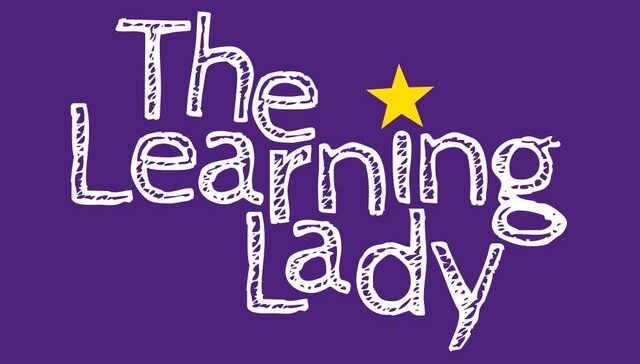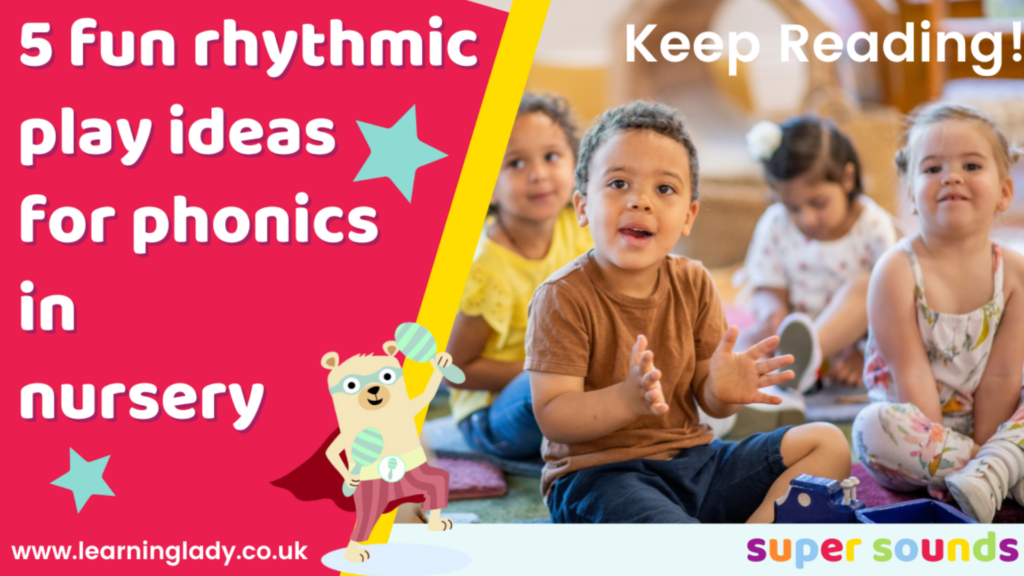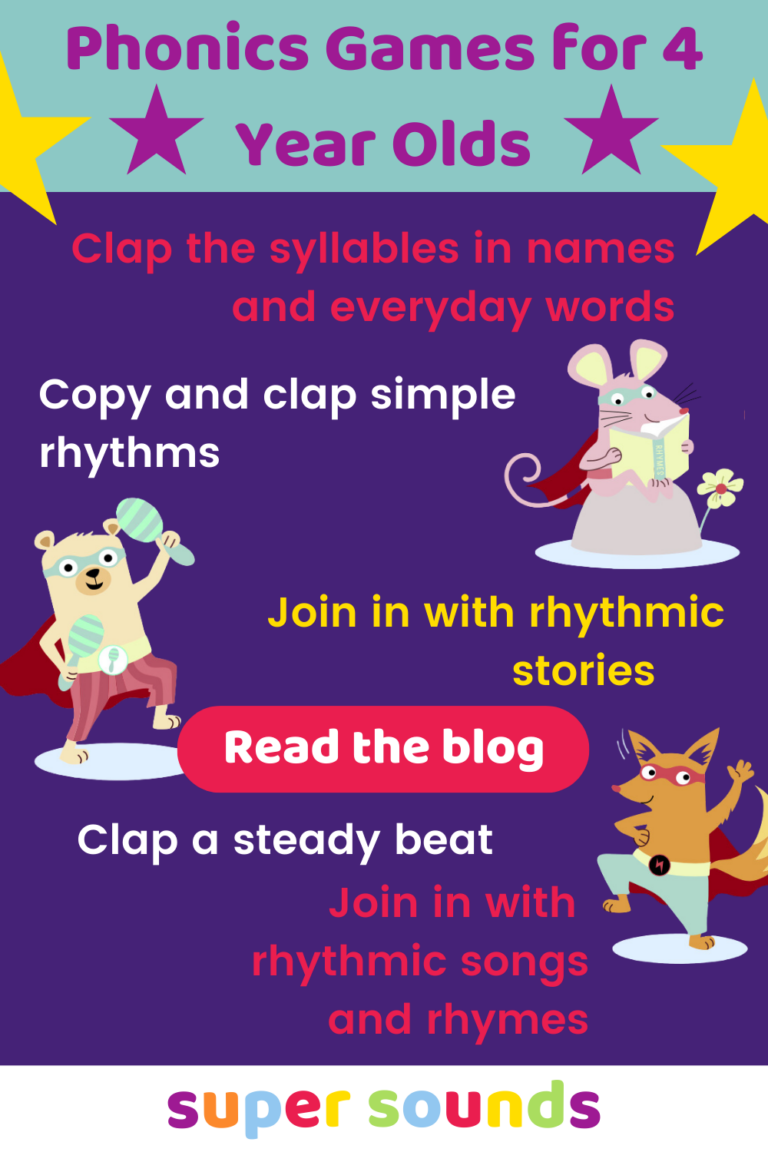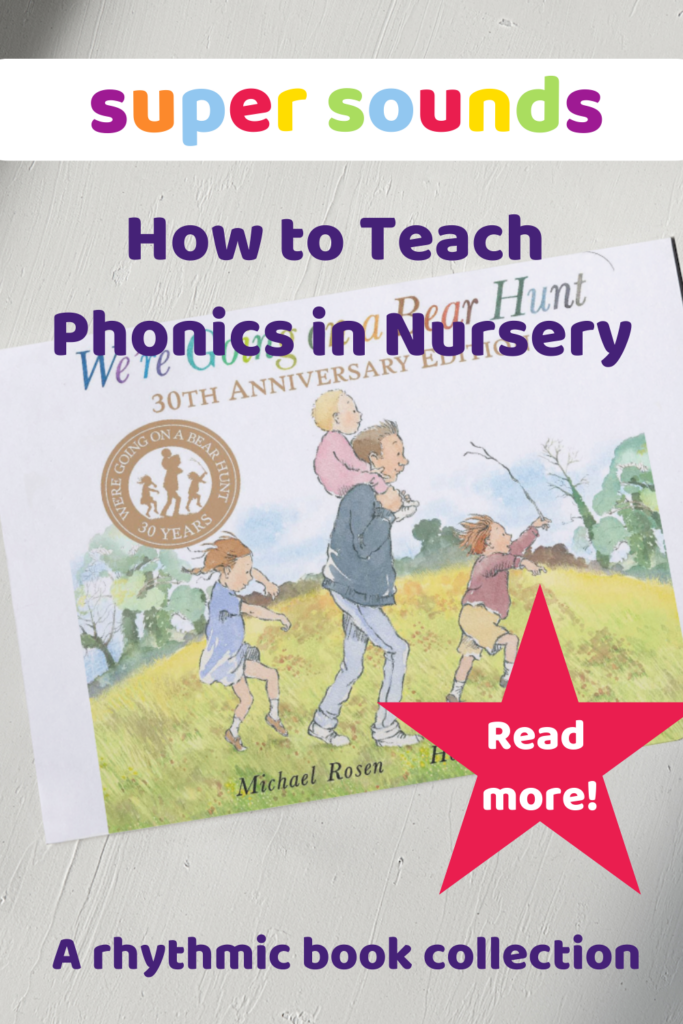Rhythmic play has long been an essential ingredient of phonics in nursery. As you read through this post it’s likely that you’ll remember being involved in rhythmic play as a child, but you probably didn’t realise that playing around with rhythm is critical to reading success.
Whether you’re a parent or early years practitioner, easy-peasy rhythmic activities are super engaging and fun. This makes preparing preschoolers for phonics enjoyable for everyone!
What is rhythmic play?
Rhythmic play involves hearing patterns of sounds. These can be musical, like joining in with clapping a steady beat, or moving to the rhythm of music.
Rhythm in language
Playing with rhythm can also relate to the patterns of sounds in words. Joining in with catchy stories and rhymes like We’re Going On a Bear Hunt or The Bus Is For Us! are great examples.
Rhythmic games can involve clapping patterns, playing musical patterns with instruments, or joining in with interactive songs that involve repetitive and patterned actions.
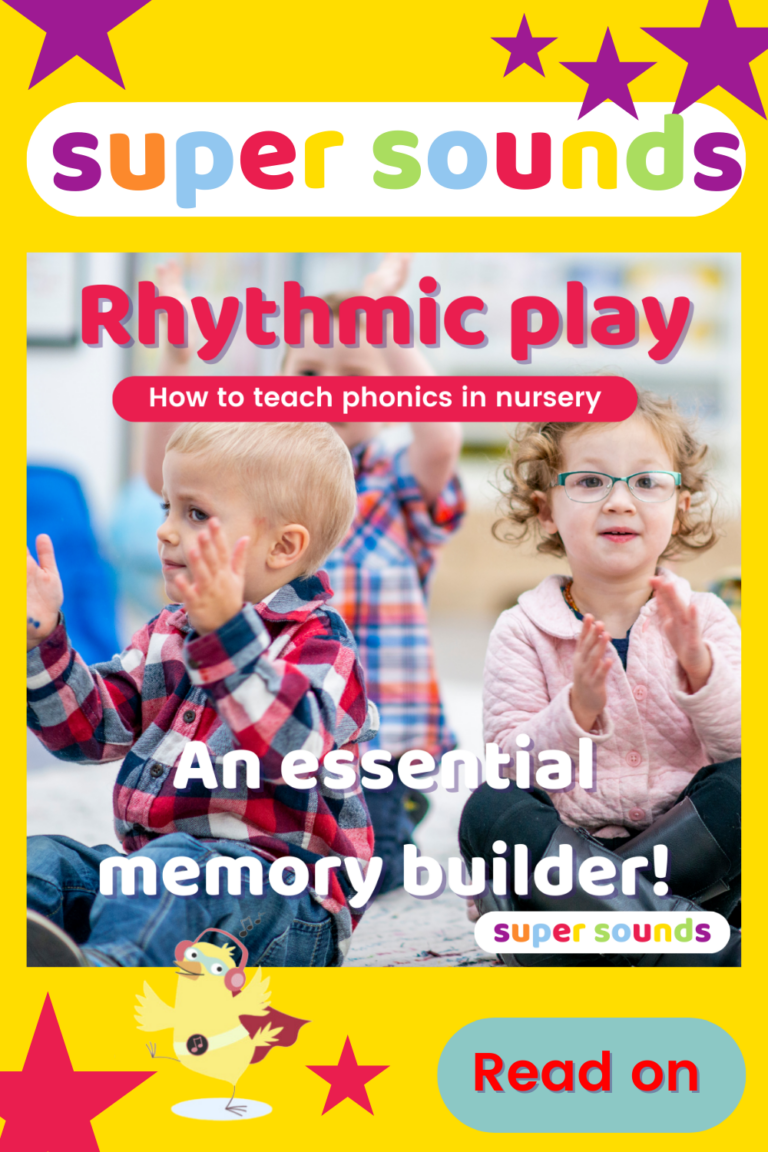
Why rhythmic play is essential phonics for 3-year-olds?
Rhythmic play is an essential element of phonics for 3 year olds because it helps young children move beyond using words for basic communication.
Repeatedly joining in with rhythmic stories, songs, and games helps preschoolers develop the idea that all spoken language is made from patterns of sounds too.
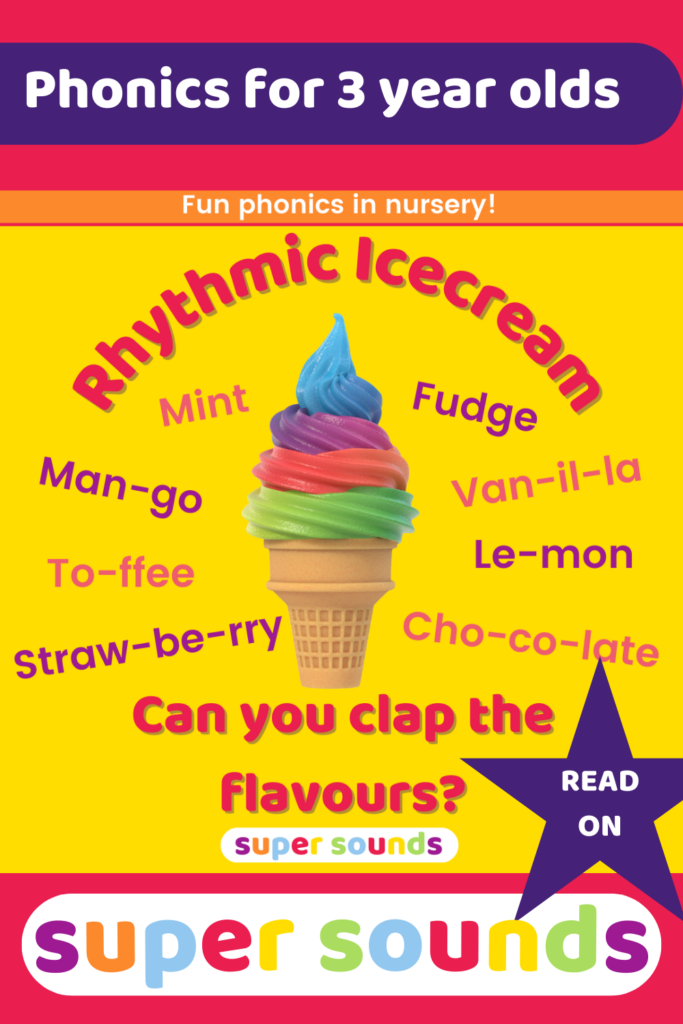
This is important because, when formal phonics teaching begins, children need to be able to match each separate spoken sound to letters. Their ears and brains must be tuned into patterns of sound to be successful.
Rhythmic play is the first building block towards being ‘reading ready’. It helps preschoolers to hear ‘chunks’ of spoken sounds in words, without the added complication of letters. This is part of what is known as phonological awareness.
A phonics nursery essential!
Rhythmic stories, songs, and games are popular with preschoolers who are eager to explore patterns in language. Their vocabularies are growing speedily, with up to 8 new words every day!
Hearing patterns in words and sounds in phonics nursery games helps young children to remember new words. This makes rhythmic play perfect for language development too.
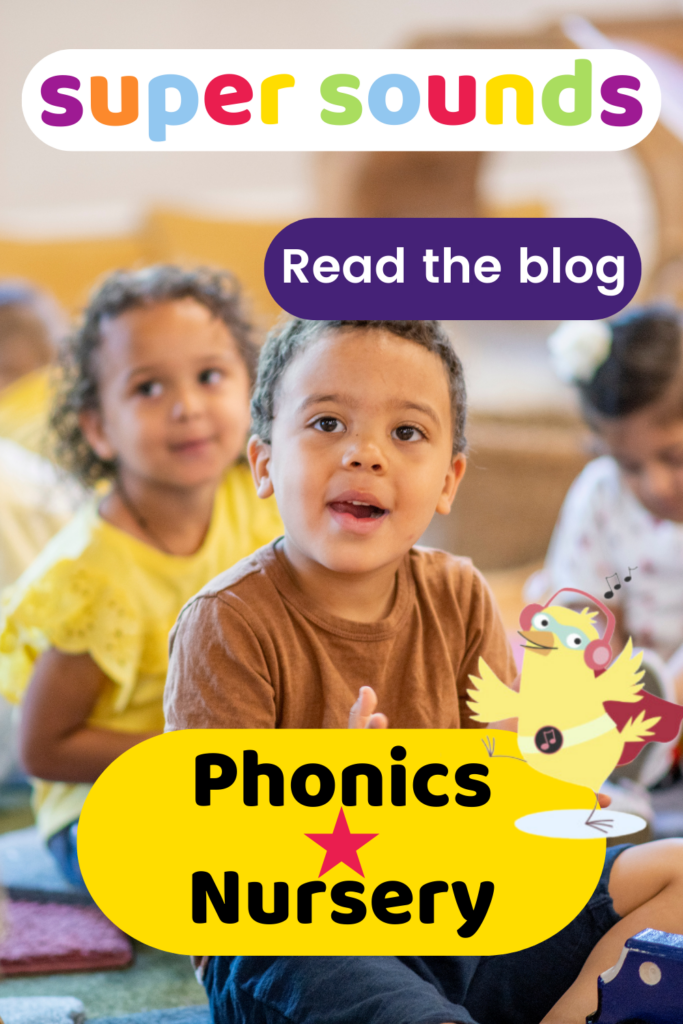
What creates rhythm in language play?
Rhythm in stories, songs, and rhymes is created by syllables. These sound like the ‘beats’ in words.
Syllables are created by vowel sounds a, e, I, o, u, so all words have at least 1 syllable or ‘beat’.
These vowels are dominant sounds in words which is how they create the ‘heartbeat of words.
Playing around with syllables in nursery phonics games
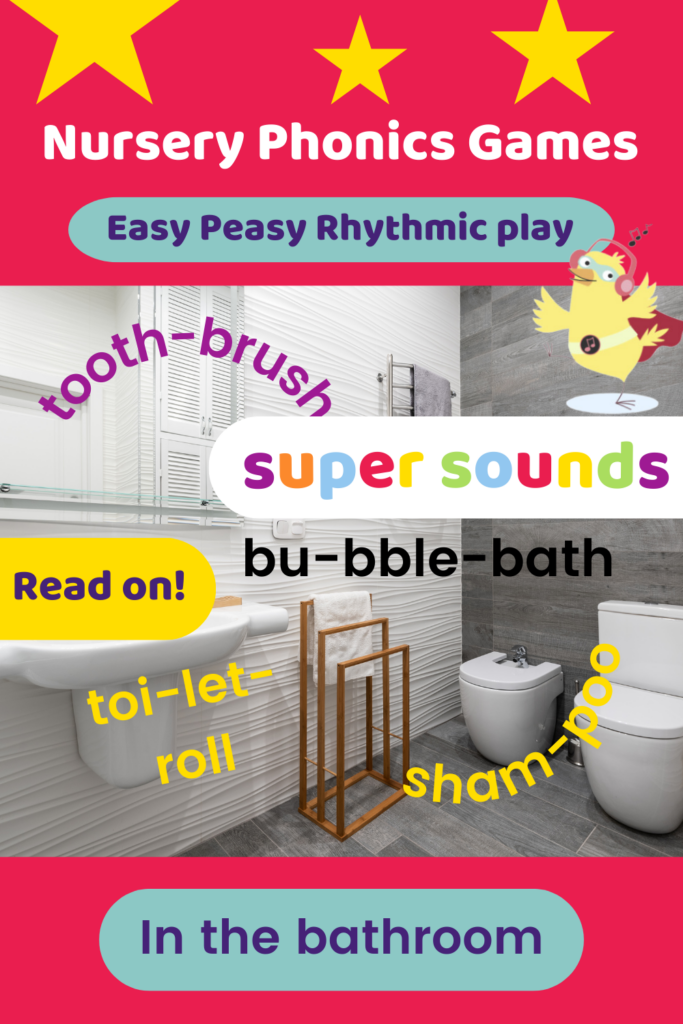
Everyday words always include vowels, and therefore syllables. As a result, it’s super simple to use toys and objects from around the home for rhythmic nursery phonics games.
Why not pick a room and providing a clapping clue for a simple treasure hunt.
In the bathroom preschoolers could look for:
Soap-1 syllable, 1 clap
Toothbrush- 2 syllables, 2 claps
Bubble bath- 3 syllables, 3 claps
Super Speedy nursery activities for 4 year olds to join in with at home
Here are some nursery activities for 4 year olds that you can play along with at home or nursery. These instantly interactive games show how clapping along to the ‘beats’ in words develops a sense of rhythm in spoken language, without things becoming too technical!
Rhythmic Nursery phonics activities build memory
Our brains are hard wired to seek out patterns to make sense of the world. Most sound pattern activities are intentionally repetitive and memorable and help with this learning process.
Nursery phonics activities involving repeating rhythmic patterns are vital for memory training to support wider learning
Rhythmic phonics games for 4 year olds matter!
Children with limited experiences of rhythmic play often have trouble hearing and remembering sounds when they start reading.
This is because they need strong mental models of patterned language and sound patterns in the brain developed through repetitive rhythmic phonics games for 4 year olds
The magic of rhythmic play
Rhythmic games, stories, and songs can also be a way of capturing the interest of more reluctant readers, being naturally repetitive and noticeably playful.
Patience was a preschooler in our nursery who had limited experience or interest in books. Her love of music and rhythmic activities was our way in to helping her engage with fun activities involving patterns of language, ready for reading
How to teach phonics in nursery using rhythmic books
There are many great rhythmic books for preschoolers that are perfect if you’re wondering how to teach phonics in nursery or at home.
Authors of books for preschoolers regularly use syllables to create stories and rhymes that are predictably rhythmic, and many are popular classics that you’ll know.
10 of the best rhythmic books for preschoolers
Phonics for nursery | Learning about Rhythm
But how do you know if your little one is ready for rhythmic phonics for nursery or at home?
As rhythmic play requires playing around with language and sounds, it’s important that children have foundational skills in place before beginning.
Skills to establish before introducing rhythmic play
- Use naming words for everyday objects, people, or actions
- Say 2-, 3- or 4-word sentences
- Match everyday sounds to animals and objects
- Make sounds matched to animals or objects
- Clap a steady beat to music
- Listen and sometimes join in with simple stories and songs.
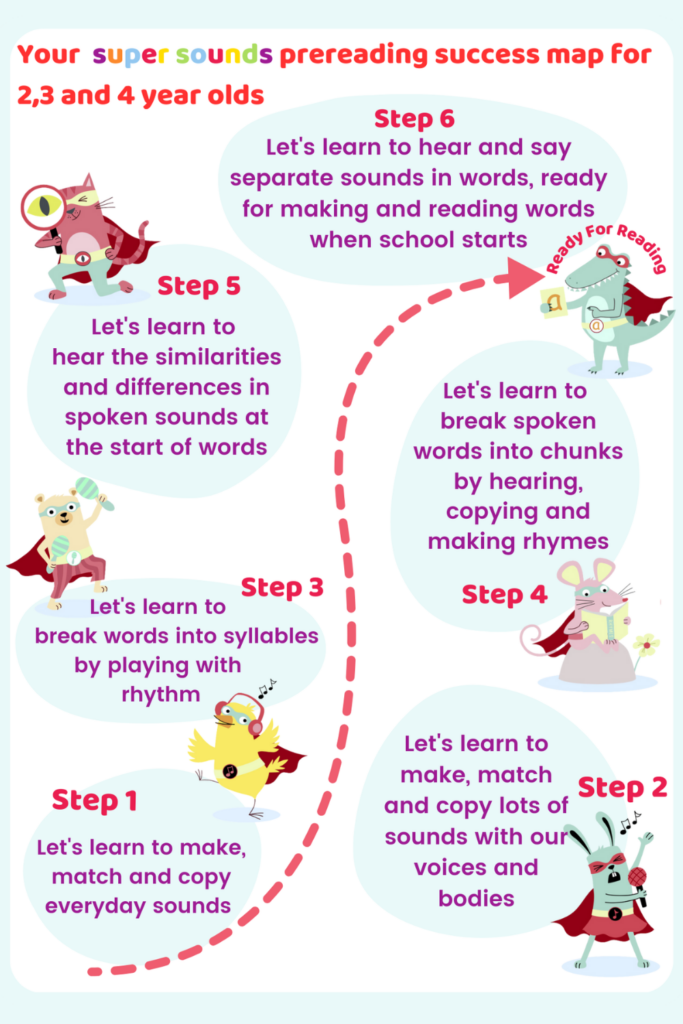
Here’s a super simple way to find out if your child is ready for rhythm. It’s a super simple, free downloadable map, illustrating a step-by-step approach to developing prephonic skills, ready for reading.
Rhythmic play skills fall under Step 3 of this map
‘Let’s learn to break words into syllables by playing with rhythm’.
It’s advised that preschoolers are independently able to achieve all Step 1 and Step 2 statements before beginning rhythmic play activities in Step 3.
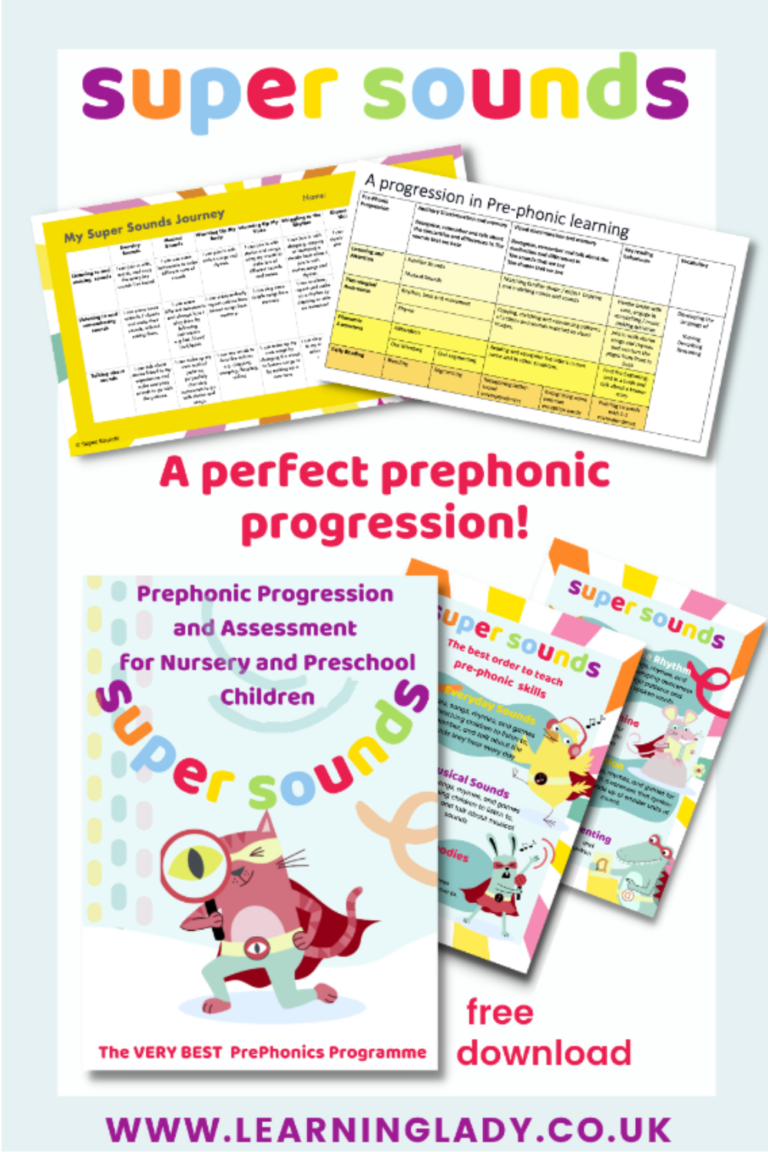
Phonics in nursery | 5 fun rhythmic games to play
So, now that you know why rhythmic play makes phonics in nursery super successful, here are 5 easy peasy games to play together.
These are all taken from Super Sounds, the unique, award winning prephonics programme, specifically designed for 2, 3- and 4-year-olds. It’s the very best foundation, setting your children up for reading success before any phonics programme.
Phonics in Nursery | Pass The Tambourine Game
Here’s a super speedy game that your 3- and 4-year-olds will love! All you need is a tambourine, and there’s no preparation required.
Phonics in Nursery | Feel The Beat
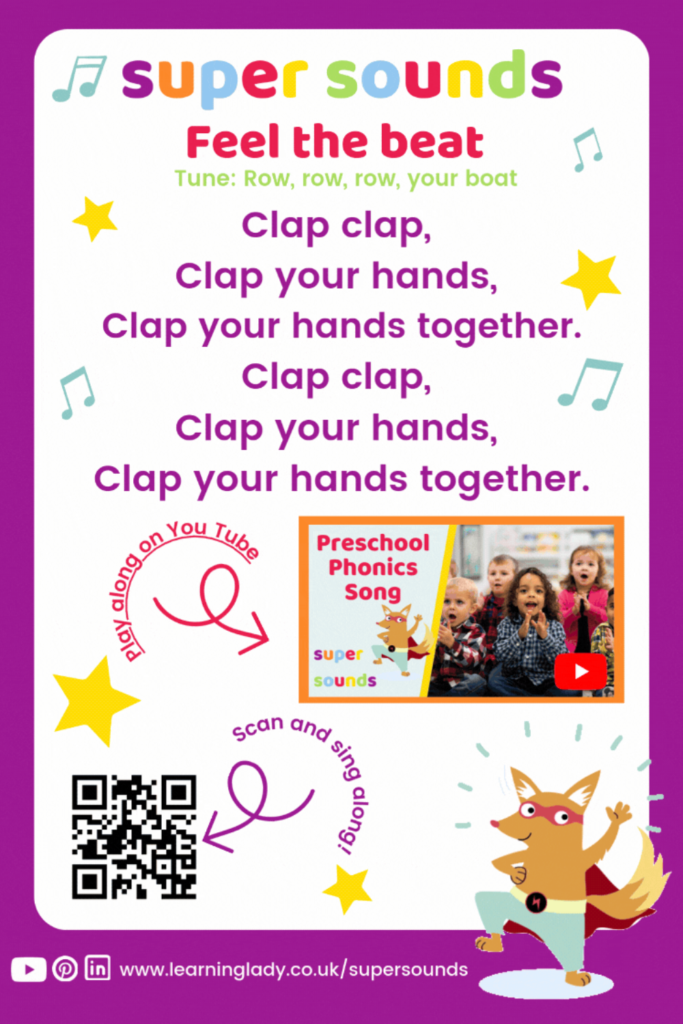
Here’s a super simple song that not only develops a sense of rhythm, but it’s great for coordination and matching words with actions too.
What you need
You don’t need anything to join in with this song!
How to play
This is a joining in song, so encourage the children to participate as much as possible with the singing and the actions.
Make sure the children have enough space between then to move freely and safely.
This can simply be sung to the tune of Row, Row, Row your boat.
Begin by modelling the first verse for the children.
Clap clap, clap your hands,
Clap your hands together.
Clap clap, clap your hands,
Clap your hands together.
Repeat a few times, encouraging the children to join in with the singing and actions all together.
As the children gain confidence repeat with further verses.
- Pat, pat, pat, pat your knees,
- Stomp, stomp, stomp your feet
- Blink, blink, blink your eyes
- Tap, tap, tap your head
- Kick, kick, kick your legs
Phonics in Nursery | Guess The Billy Goat
Are your preschoolers interested in traditional tales? If so, this super simple game based on Nick Sharratts Three Billy Goats Gruff is just what you need. Listen to the patterns and guess who’s trip, trapping over the bridge. And don’t forget to look out for the troll!
Phonics in Nursery | Little Drummer’s Drumming
Here’s another low prep rhythmic game that your preschoolers will love coming back to over and over again. Once the children know how to play, leave the drum out for them to use, and see how much they enjoy playing together.
What you need
A drum, placed in the centre of the space
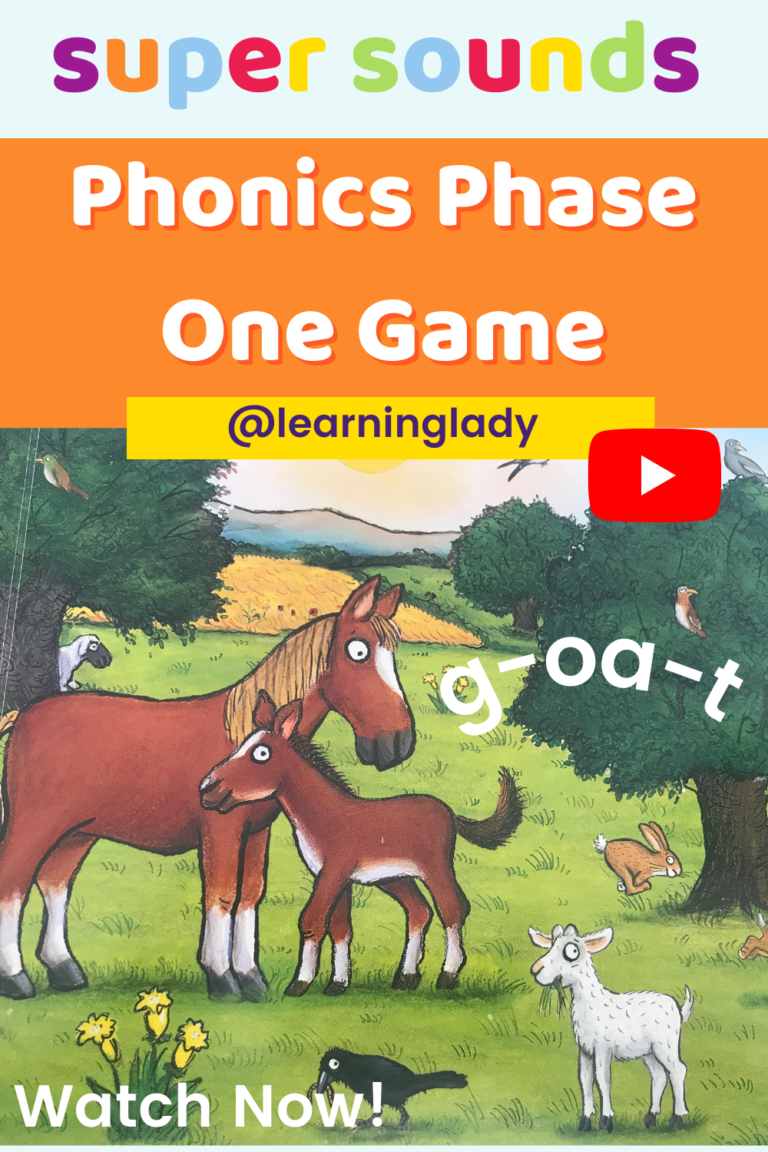
How to play
Begin by clapping the syllables in each child’s name all together. The syllables are the ‘beats’ in words, each syllable or beat is created by a vowel.
For example
Jack (1 clap)
Oscar (2 claps)
Khadija (3 claps)
Abdulrahman (4 claps)
Model tapping some of the names on the drum too.
Choose one of children to be the first drummer. This child should go and sit with the drum in the centre of the space.
Demonstrate singing this Little Drummer song, encouraging the children to clap a steady beat as you sing.
“Molly is the drummer,
Molly is the drummer,
Molly is the drummer,
Let’s hear her play her name.”
This can be sung to the tune of The bear went over the mountain
When the first verse has ended, encourage the child drummer to play their name, by saying it aloud, then tapping the syllables on the drum. For example, Moll-y (2 beats on the drum).
Encourage the children without a drum to continue singing the second verse of the Little Drummer song all together.
Model then encourage the drummer to play the syllables and say their name aloud at the appropriate points in the song.
For example
“She plays her name like this.
Moll-y (drummer plays 2 drumbeats)
She plays her name like this.”
Moll-y (drummer plays 2 drumbeats)
Complete the song by repeating the first verse, with all the children keeping a steady beat by clapping, with the drummer tapping a steady beat as before.
“Molly is the drummer,
Molly is the drummer,
Molly is the drummer,
We heard her play her name.”
Repeat the process with further drummers, encouraging increased participation as the children grow in confidence.
Phonics in Nursery | Which Animal is hiding?
You can play this easy peasy rhythmic game using any toy animals you have. It’s a versatile game where you can also swap the animals for other toys (like vehicles or minibeasts), favourite characters, or objects from around the home. It’s great to follow the children.
More Nursery planning ideas to use today!
Super Sounds by The Learning Lady
Ready For Reading Online Training for Early Years practitioners
FREE Recommended Reading books for Preschool Phonics
Rhythmic Early Years Clapping Game
Why developing phonological awareness for your 3 and 4 year olds is important
What comes before Phonics by Sally Neaum
